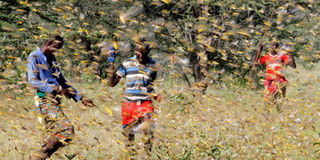Kenya hires foreign experts to fight locusts

Residents fight locusts in Kenya recently. The locust invasion in East Africa is the biggest in Kenya in 70 years, according to the FAO. COURTESY PHOTO
What you need to know:
- As a result, new swarms are expected to form in March and April. Mature swarms were spotted in Uganda, Tanzania and South Sudan late last week.
- In Migori County, swathes of locusts spotted in Suna West sub-county were sprayed with insecticide and contained.
Kenyan government has roped in foreign experts in the fight against the desert locust invasion that has affected 17 counties so far.
A Moroccan professional was among a group of specialists who were training servicemen from the National Youth Service (NYS) in Gilgil on ground control of the migratory pests.
AERIAL SPRAYING
“Kenya is not a desert locust country, and we don’t have much experience, so we needed partners with the requisite experience on how to combat the species. That is why we are combining forces,” said David Mwangi, head of plant protection in the Agriculture ministry.
He added: “We want to focus on the ground spraying mainly because we are having new hatchings and hoppers — the swarms that came have laid eggs and we want to control them on the ground before they develop wings,” Mr Mwangi explained.
He said that they will use hand spraying and vehicle mounted equipment. At the same time, he said, the aerial spraying will go on.
To shore up the effort, Kenyan government has enlisted the help of 120 extension service providers, and 600 NYS servicemen are expected to join the efforts.
Separately, Agriculture Principal Secretary Hamadi Boga said 7,500 litres of Fenitrothione, which is used in aerial spraying, and other chemicals for ground spraying had been received and were being distributed to affected counties.
Meanwhile, a humanitarian crisis is looming in Kenya as desert locusts continue to breed and spread. According to FAO, the locust invasion in the East African region could turn into a full-blown crisis in a few weeks.
“Widespread egg laying and hatching have started, and so far numerous dense early instar hopper bands are present in some central areas,” said FAO.
As a result, new swarms are expected to form in March and April. Mature swarms were spotted in Uganda, Tanzania and South Sudan late last week.
In Migori County, swathes of locusts spotted in Suna West sub-county were sprayed with insecticide and contained.
In Meru, a swarm was reported to have landed in Mitunguu, which is considered the county’s food basket.




